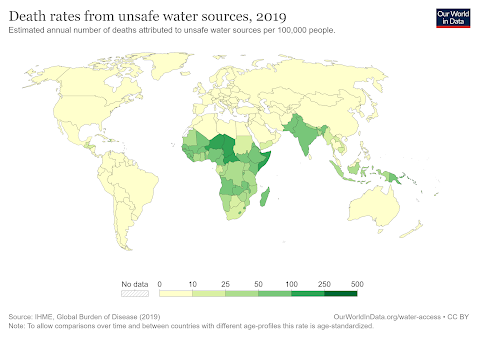Why write about water and sanitation in Africa?
Did you know that every day nearly 1000 children die due to preventable water and sanitation related diarrheal diseases? Or that 2 in 5 people don’t have access to a basic hand washing facility (with soap and water)?
Welcome
to the WASH web, where over the following weeks I will be exploring some of the
key issues related to water and sanitation in Africa. Including access to
‘improved’ water, toilets and handwashing and women and water, sanitation and hygiene
(WASH).
Globally
there is an unequal distribution in the deaths attributed to unsafe water. Figure
1 shows that Sub-Saharan Africa has much higher death rates than other regions –
with some countries, such as Chad having over 100 deaths per 100,000 people. Therefore,
improving water and sanitation in Africa is critical if SDG 6 (clean water and sanitation)
is to be met by 2030.
Figure 1: Map to show global distribution in death rates from unsafe water sources, 2019
My
interest in water and sanitation came from my travels this summer in Fiji. I
was living in remote villages, experiencing first-hand their water and
sanitation systems. Doesn’t the idea of drinking Fiji Water, the ‘earths finest
water’, that evokes purity, straight from the source sound amazing? So, I thought,
until becoming unwell, from presumably a water borne illness. I hadn’t considered
the realities of water supply in rural areas of the island, which made me begin
to rethink what water I was drinking.
Figure 2: Fiji Water Advertisement
Despite there being reported
96% of access to improved drinking water in Fiji (defined
as being protected from contamination – mainly faecal), in reality this is
often different. In one study, E coli was detected in multiple sources across
communities in Naviti island. Typhoid and leptospirosis are also a concern in Fiji,
where sanitation can be poor and flooding can
spread contaminated water.
My
time spent on a small island just off the mainland in Fiji brought water
availability to my attention. Low-lying islands often rely on groundwater and
rainwater harvesting, where surface water availability is low. In response to low water supply,
this island implemented ecological sanitation. These are toilets that require
no water and turn waste into compost, reducing health risks associated with
contaminated water and waste and lowering water demand.
I am
interested to see if these topics and issues from my travels can translate into
the African context; one that I am unfamiliar with. During my blogs, I will critically
engage with reports, such as those produced by NGOs, and find case studies on
the ground that may shed light on realties – see my next blog for more. I also
recognise my positionality and that I am not trying to become a white saviour, but
to understand lived experiences of water and sanitation in Africa. As Wainaina’s article
points out, Africa is not one homogenous area, so I will strive to not use
oversimplified terms and I will recognise the variations within and between
countries and their people.





Comments
Post a Comment